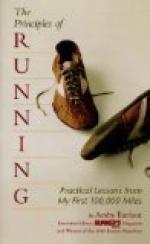Certainly we are starting at the bottom of the ladder. These trenches are badly sited, badly constructed, difficult of access from the rear, and swarming with large, fat, unpleasant flies, of the bluebottle variety. They go to sleep, chiefly upon the ceiling of one’s dug-out, during the short hours of darkness, but for twenty hours out of twenty-four they are very busy indeed. They divide their attentions between stray carrion—there is a good deal hereabout—and our rations. If you sit still for five minutes they also settle upon you, like pins in a pin-cushion. Then, when face, hands, and knees can endure no more, and the inevitable convulsive wriggle occurs, they rise in a vociferous swarm, only to settle again when the victim becomes quiescent. To these, high-explosives are a welcome relief.
The trenches themselves are no garden city, like those at Armentieres. They were sited and dug in the dark, not many weeks ago, to secure two hundred yards of French territory recovered from the Bosche by bomb and bayonet. (The captured trench lies behind us now, and serves as our second line.) They are muddy—you come to water at three feet—and at one end, owing to their concave formation, are open to enfilade. The parapet in many places is too low. If you make it higher with sandbags you offer the enemy a comfortable target: if you deepen the trench you turn it into a running stream. Therefore long-legged subalterns crawl painfully past these danger-spots on all-fours, envying Little Tich.
Then there is Zacchaeus. We call him by this name because he lives up a tree. There is a row of pollarded willows standing parallel to our front, a hundred and fifty yards away. Up, or in, one of these lives Zacchaeus. We have never seen him, but we know he is there; because if you look over the top of the parapet he shoots you through the head. We do not even know which of the trees he lives in. There are nine of them, and every morning we comb them out, one by one, with a machine-gun. But all in vain. Zacchaeus merely crawls away into the standing corn behind his trees, and waits till we have finished. Then he comes back and tries to shoot the machine-gun officer. He has not succeeded yet, but he sticks to his task with gentle persistence. He is evidently of a persevering rather than vindictive disposition.
Then there is Unter den Linden. This celebrated thoroughfare is an old communication-trench. It runs, half-ruined, from the old German trench in our rear, right through our own front line, to the present German trenches. It constitutes such a bogey as the Channel Tunnel scheme once was: each side sits jealously at its own end, anticipating hostile enterprises from the other. It is also the residence of “Minnie.” But we will return to Minnie later.
The artillery of both sides, too, contributes its mite. There is a dull roar far in the rear of the German trenches, followed by a whirring squeak overhead. Then comes an earth-shaking crash a mile behind us. We whip round, and there, in the failing evening light, against the sunset, there springs up the silhouette of a mighty tree in full foliage. Presently the silhouette disperses, drifts away, and—




